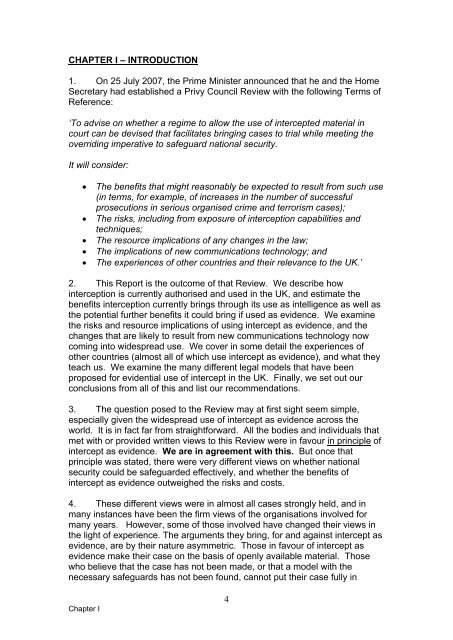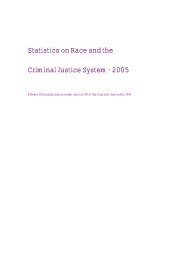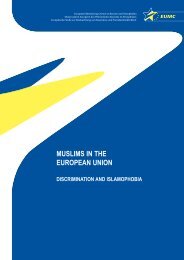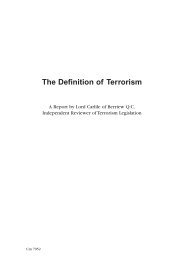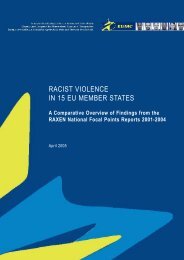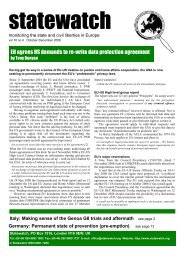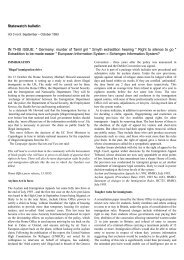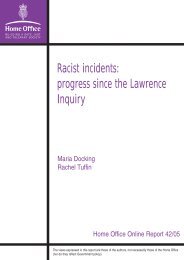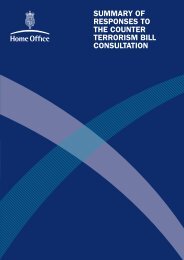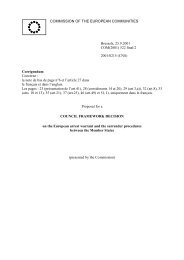Privy Council Review of intercept as evidence: report - Official ...
Privy Council Review of intercept as evidence: report - Official ...
Privy Council Review of intercept as evidence: report - Official ...
You also want an ePaper? Increase the reach of your titles
YUMPU automatically turns print PDFs into web optimized ePapers that Google loves.
CHAPTER I – INTRODUCTION<br />
1. On 25 July 2007, the Prime Minister announced that he and the Home<br />
Secretary had established a <strong>Privy</strong> <strong>Council</strong> <strong>Review</strong> with the following Terms <strong>of</strong><br />
Reference:<br />
‘To advise on whether a regime to allow the use <strong>of</strong> <strong>intercept</strong>ed material in<br />
court can be devised that facilitates bringing c<strong>as</strong>es to trial while meeting the<br />
overriding imperative to safeguard national security.<br />
It will consider:<br />
<br />
<br />
<br />
<br />
<br />
The benefits that might re<strong>as</strong>onably be expected to result from such use<br />
(in terms, for example, <strong>of</strong> incre<strong>as</strong>es in the number <strong>of</strong> successful<br />
prosecutions in serious organised crime and terrorism c<strong>as</strong>es);<br />
The risks, including from exposure <strong>of</strong> <strong>intercept</strong>ion capabilities and<br />
techniques;<br />
The resource implications <strong>of</strong> any changes in the law;<br />
The implications <strong>of</strong> new communications technology; and<br />
The experiences <strong>of</strong> other countries and their relevance to the UK.’<br />
2. This Report is the outcome <strong>of</strong> that <strong>Review</strong>. We describe how<br />
<strong>intercept</strong>ion is currently authorised and used in the UK, and estimate the<br />
benefits <strong>intercept</strong>ion currently brings through its use <strong>as</strong> intelligence <strong>as</strong> well <strong>as</strong><br />
the potential further benefits it could bring if used <strong>as</strong> <strong>evidence</strong>. We examine<br />
the risks and resource implications <strong>of</strong> using <strong>intercept</strong> <strong>as</strong> <strong>evidence</strong>, and the<br />
changes that are likely to result from new communications technology now<br />
coming into widespread use. We cover in some detail the experiences <strong>of</strong><br />
other countries (almost all <strong>of</strong> which use <strong>intercept</strong> <strong>as</strong> <strong>evidence</strong>), and what they<br />
teach us. We examine the many different legal models that have been<br />
proposed for evidential use <strong>of</strong> <strong>intercept</strong> in the UK. Finally, we set out our<br />
conclusions from all <strong>of</strong> this and list our recommendations.<br />
3. The question posed to the <strong>Review</strong> may at first sight seem simple,<br />
especially given the widespread use <strong>of</strong> <strong>intercept</strong> <strong>as</strong> <strong>evidence</strong> across the<br />
world. It is in fact far from straightforward. All the bodies and individuals that<br />
met with or provided written views to this <strong>Review</strong> were in favour in principle <strong>of</strong><br />
<strong>intercept</strong> <strong>as</strong> <strong>evidence</strong>. We are in agreement with this. But once that<br />
principle w<strong>as</strong> stated, there were very different views on whether national<br />
security could be safeguarded effectively, and whether the benefits <strong>of</strong><br />
<strong>intercept</strong> <strong>as</strong> <strong>evidence</strong> outweighed the risks and costs.<br />
4. These different views were in almost all c<strong>as</strong>es strongly held, and in<br />
many instances have been the firm views <strong>of</strong> the organisations involved for<br />
many years. However, some <strong>of</strong> those involved have changed their views in<br />
the light <strong>of</strong> experience. The arguments they bring, for and against <strong>intercept</strong> <strong>as</strong><br />
<strong>evidence</strong>, are by their nature <strong>as</strong>ymmetric. Those in favour <strong>of</strong> <strong>intercept</strong> <strong>as</strong><br />
<strong>evidence</strong> make their c<strong>as</strong>e on the b<strong>as</strong>is <strong>of</strong> openly available material. Those<br />
who believe that the c<strong>as</strong>e h<strong>as</strong> not been made, or that a model with the<br />
necessary safeguards h<strong>as</strong> not been found, cannot put their c<strong>as</strong>e fully in<br />
Chapter I<br />
4


